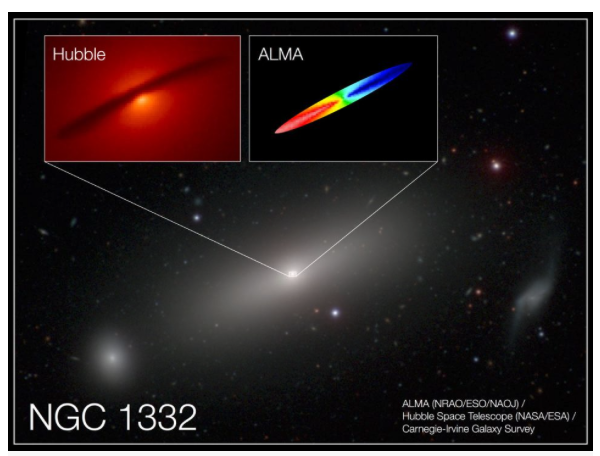
|
Combined image of NGC 1332 shows the central disk of gas surrounding the supermassive black hole at the center of the galaxy. The box in the upper left from the Hubble Space Telescope shows the galaxy's central region in infrared light and the dusty disk appears as a dark silhouette. The ALMA image, upper right box, shows the rotation of the disk, enabling astronomers to calculate its mass. The red region in the ALMA image represents emission that has been redshifted by gas rotating away from us; the blue represents blue-shifted gas rotating toward us. The range of colors represent rotational speeds up to 500 kilometers per second. A. Barth (UC Irvine), ALMA (NRAO/ESO/NAOJ); NASA/ESA Hubble; Carnegie-Irvine Galaxy Survey. |
|
Data from Atacama Large Millimeter/submillimeter Array made
measurement possible
Irvine, Calif., May 5, 2016 – Astronomers from the University of California, Irvine and other universities have derived a highly precise measurement of the mass of a black hole at the center of a nearby giant elliptical galaxy. Working with high-resolution data from the Atacama Large Millimeter/submillimeter Array in Chile, the scientists were able to determine the speed of a disk of cold molecular gas and dust orbiting the supermassive black hole at the heart of galaxy NGC 1332. From there, they calculated the black hole’s mass to be 660 million times greater than that of the Sun.
“This is the first time that ALMA has probed the orbital motion of cold molecular gas well inside the gravitational sphere of influence of a supermassive black hole” said Aaron Barth, UCI professor of physics & astronomy and lead author on the study published today in the Astrophysical Journal Letters. “We’re directly viewing the region where the cold gas is responding to the black hole’s gravitational pull. This is an exciting milestone for ALMA and a great demonstration of its high-resolution capability.”
To calculate the mass of a black hole in a galaxy’s center, astronomers must be able to measure the speed of something orbiting around it, Barth said.
“For a precise measurement, we need to zoom in to the very center of a galaxy where the black hole’s gravitational pull is the dominant force. ALMA is a fantastic new tool for carrying out these observations.”
|

